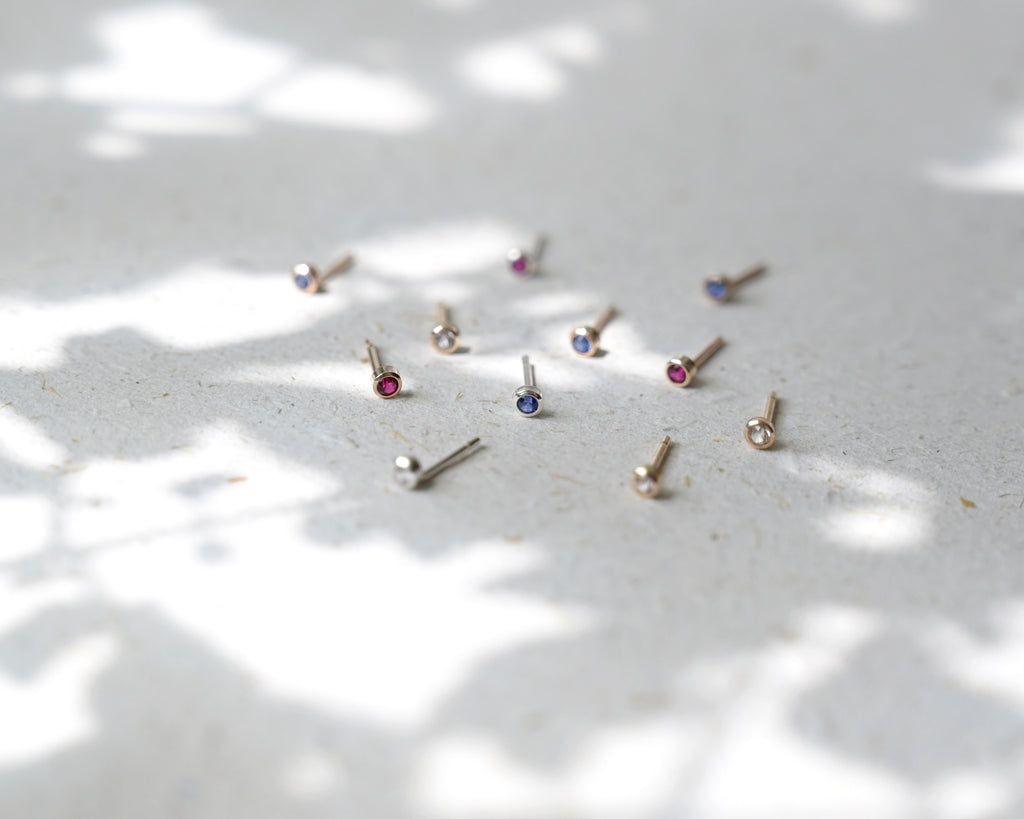The team at Wild Fawn have always wanted to create designs with gemstones in our jewellery collections. The addition of stones brings a whole new level of design options and means we can offer our lovely customers even more new pieces for their jewellery box.
However, gemstones, and diamonds especially, come with a lot of questions and issues to consider. Unfortunately most gemstones on the market cannot be traced, we have to trust suppliers are sourcing their stones responsibly and are a vigorous in their checks as we want but have no guarantee. However fully traceable stones are, for us, prohibitively expensive. (for now!)
We have long discussed the pros and cons of gemstones and looked for alternatives; “Lab-grown”, "synthetic”, “artificial”, “human-made” gems, or "above ground" stones as we like to call them, are gemstones that have been created in labs and foundries rather than in the ground. Essentially, the millions-years long process of heat and pressure involved in creating a natural gem underground is mimicked in a lab in a fraction of the time.
Most nature lovers who are conscious of the environment want to wear a piece of nature, a natural gemstone, so the term “lab-grown” can feel uncomfortable and as if it's something unnatural. Not so! The only difference between a lab-grown stone and a mined gemstone is its point of origin.

The word "synthetic" comes with many stigmas but the base stones have the exact chemical composition of the same stone created by mother earth. All gemstones come from a few base types like family trees:
- The Corundum family of gemstones consists of ruby and sapphire. Most people think red and blue when they think of ruby and sapphire but they are actually very versatile stones, sapphire exists in an array of colours including orange, yellow, green and even pink.
- Beryl is a mineral composed of beryllium aluminum cyclosilicate (catchy right!?). Beryl is usually a light green but is sometimes heat treated to create aquamarine. Deep green beryl is more commonly known as emerald, one of the most precious gemstones!
- Spinels are allochromatic gemstones. This means that when the mineral is pure, it's colourless... The majority of jewellery gems, such as beryl (emerald, aquamarine, etc), corundum (ruby and sapphire), quartz, and topaz, are allochromatic. All have colourless varieties formed without the colour-making impurities.
- Quartz is one of the most common and varied minerals on earth, and it's abundant colours produce many gemstone types. Amethyst and Citrine are the most popular and valuable gem varieties of Quartz.
- Garnet, named for the Latin word granatum, meaning seeds of pomegranate, a very appropriate name considering its colour. Garnet is the head of it's own stone family!

Lab-grown are real gemstones in every sense: chemically, physically and optically. They are typically created in very modern foundries by highly skilled staff who receive fair wages and benefits, unlike most ground mining operations. Our suppliers says "Lab created and Lab grown and synthetic are synonymous terms. To use any of these terms, according to the FTC (Federal Trade Commission), the gemstone must be identical to the natural in every way. Composition, Hardness, and Optically."
We know what you really want to know is; are lab-grown gemstones eco-friendly? Although no gemstone has zero environmental impact, it's true that the production of lab-grown gems has a much smaller impact on the environment than traditional mining. Ground mining requires moving large amounts of earth and can create a lot of drinking water pollution, not so for lab-grown.
Yes labs and foundries do use energy and chemicals but the carbon footprint of lab growers is a small fraction of natural gemstone mining, fair trade or not. An ABN Amro report found that it takes an average of 26 kWh to grow a round diamond but 57 kWh to mine one and that doesn't even factor in cave and mine exploration and transportation.
The biggest environmental issues associated with diamond mining are soil erosion, deforestation, loss of habitat for wildlife, water pollution and in extreme cases has been known to cause entire ecosystems to collapse. Lab-grown gemstones have a significantly lower impact on the environment. Lab-grown diamonds use 86% less water and 50% less energy, and produce a whopping 95% less in carbon emissions than their mined counterparts, making them a much more eco-friendly choice.
The worst human cost of natural diamonds are unsafe working conditions, slave labour and violence, lab-grown stones are guaranteed 100% conflict free.
However, diamond industry and wider jewellery industry commentators aren't convinced that lab-grown gems are the perfect ideal solution to the ethical and environmental shortcomings of the diamond trade. There is a bigger picture. Approximately 10 million people work in the diamond industry, in some of the poorest areas of the world, not always in the best of conditions but the diamond industry is attributed to $8 billion a year in Africa. In the short term lab-grown stones can take some demand away from small artisnal mines and the people who reply on them but ultimately there is a finite source of gemstones in the ground, it cannot last forever, alternatives need to be explored.

"When natural diamond resources start to deplete the prices of mined diamonds will be out of reach to the average consumer – they will have no choice but to buy man-made. While this is a potential concern for the diamond mining industry, it's a win for consumers, mining communities and the environment" - The Guardian
The stones you may see us offer and their family:
- Lab Emerald - Beryl
- Lab Aquamarine - Beryl
- Lab Alexandrite - Chysoberyl
- Lab Ruby - Corundum
- Lab Sapphire - Corundum
- Lab Spinel - Spinel
- Lab Diamond - Diamond
- Lab Amethyst - Quartz
- Lab Citrine - Quartz
- Lab Garnet - Garnet






